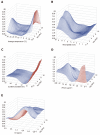Relationship of meteorological factors and air pollutants with medical care utilization for gastroesophageal reflux disease in urban area
- PMID: 33132656
- PMCID: PMC7584054
- DOI: 10.3748/wjg.v26.i39.6074
Relationship of meteorological factors and air pollutants with medical care utilization for gastroesophageal reflux disease in urban area
Abstract
Background: Gastroesophageal reflux disease (GERD) is a highly prevalent disease of the upper gastrointestinal tract, and it is associated with environmental and lifestyle habits. Due to an increasing interest in the environment, several groups are studying the effects of meteorological factors and air pollutants (MFAPs) on disease development.
Aim: To identify MFAPs effect on GERD-related medical utilization.
Methods: Data on GERD-related medical utilization from 2002 to 2017 were obtained from the National Health Insurance Service of Korea, while those on MFAPs were obtained from eight metropolitan areas and merged. In total, 20071900 instances of GERD-related medical utilizations were identified, and 200000 MFAPs were randomly selected from the eight metropolitan areas. Data were analyzed using a multivariable generalized additive Poisson regression model to control for time trends, seasonality, and day of the week.
Results: Five MFAPs were selected for the prediction model. GERD-related medical utilization increased with the levels of particulate matter with a diameter ≤ 2.5 μm (PM2.5) and carbon monoxide (CO). S-shaped and inverted U-shaped changes were observed in average temperature and air pollutants, respectively. The time lag of each variable was significant around nine days after exposure.
Conclusion: Using five MFAPs, the final model significantly predicted GERD-related medical utilization. In particular, PM2.5 and CO were identified as risk or aggravating factors for GERD.
Keywords: Air pollution; Carbon monoxide; Gastroesophageal reflux disease; Meteorological factor; Particulate matter.
©The Author(s) 2020. Published by Baishideng Publishing Group Inc. All rights reserved.
Conflict of interest statement
Conflict-of-interest statement: Authors have no conflicts of interest or financial ties to disclose.
Figures




Similar articles
-
Effect of meteorological factors and air pollutants on fractures: a nationwide population-based ecological study.BMJ Open. 2021 Jun 11;11(6):e047000. doi: 10.1136/bmjopen-2020-047000. BMJ Open. 2021. PMID: 34117046 Free PMC article.
-
The Impact of Air Pollutants and Meteorological Factors on Chronic Obstructive Pulmonary Disease Exacerbations: A Nationwide Study.Ann Am Thorac Soc. 2022 Feb;19(2):214-226. doi: 10.1513/AnnalsATS.202103-298OC. Ann Am Thorac Soc. 2022. PMID: 34499589
-
Association of meteorological factors and atmospheric particulate matter with the incidence of pneumonia: an ecological study.Clin Microbiol Infect. 2020 Dec;26(12):1676-1683. doi: 10.1016/j.cmi.2020.03.006. Epub 2020 Mar 14. Clin Microbiol Infect. 2020. PMID: 32184173
-
Association of meteorological factors and ambient air pollution on medical care utilization for urolithiasis: a population-based time-series study.BMC Nephrol. 2021 Dec 2;22(1):402. doi: 10.1186/s12882-021-02614-5. BMC Nephrol. 2021. PMID: 34856940 Free PMC article.
-
Characterization of PM2.5, gaseous pollutants, and meteorological interactions in the context of time-series health effects models.J Expo Sci Environ Epidemiol. 2007 Dec;17 Suppl 2:S45-60. doi: 10.1038/sj.jes.7500627. J Expo Sci Environ Epidemiol. 2007. PMID: 18079764
Cited by
-
Gastroesophageal disease risk and inhalational exposure a systematic review and meta-analysis.Sci Rep. 2025 Jul 2;15(1):22581. doi: 10.1038/s41598-025-06620-7. Sci Rep. 2025. PMID: 40593094 Free PMC article.
-
Biomarkers of Airway Disease, Barrett's and Underdiagnosed Reflux Noninvasively (BAD-BURN) in World Trade Center exposed firefighters: a case-control observational study protocol.BMC Gastroenterol. 2024 Aug 9;24(1):255. doi: 10.1186/s12876-024-03294-9. BMC Gastroenterol. 2024. PMID: 39123126 Free PMC article.
-
Association between wet-bulb globe temperature with gastroesophageal reflux disease in different geographic regions in a large Taiwanese population study.Sci Rep. 2025 Jul 1;15(1):21339. doi: 10.1038/s41598-025-07073-8. Sci Rep. 2025. PMID: 40596482 Free PMC article.
-
Environmental effects of surgical procedures and strategies for sustainable surgery.Nat Rev Gastroenterol Hepatol. 2023 Jun;20(6):399-410. doi: 10.1038/s41575-022-00716-5. Epub 2022 Dec 8. Nat Rev Gastroenterol Hepatol. 2023. PMID: 36481812 Free PMC article. Review.
-
Mini Review: The Impact of Climate Change on Gastrointestinal Health.Middle East J Dig Dis. 2023 Apr;15(2):72-75. doi: 10.34172/mejdd.2023.325. Epub 2023 Apr 30. Middle East J Dig Dis. 2023. PMID: 37546513 Free PMC article. Review.
References
-
- Mazzucchelli R, Crespí-Villarías N, Pérez-Fernández E, Durbán Reguera ML, Guzón Illescas O, Quirós J, García-Vadillo A, Carmona L, Rodriguez-Caravaca G, Gil de Miguel A. Weather conditions and their effect on seasonality of incident osteoporotic hip fracture. Arch Osteoporos. 2018;13:28. - PubMed
-
- Stratil P, Wallmueller C, Schober A, Stoeckl M, Hoerburger D, Weiser C, Testori C, Krizanac D, Spiel A, Uray T, Sterz F, Haugk M. Seasonal variability and influence of outdoor temperature on body temperature of cardiac arrest victims. Resuscitation. 2013;84:630–634. - PubMed
-
- Hensel M, Geppert D, Kersten JF, Stuhr M, Lorenz J, Wirtz S, Kerner T. Association between Weather-Related Factors and Cardiac Arrest of Presumed Cardiac Etiology: A Prospective Observational Study Based on Out-of-Hospital Care Data. Prehosp Emerg Care. 2018;22:345–352. - PubMed
MeSH terms
Substances
LinkOut - more resources
Full Text Sources
Medical

